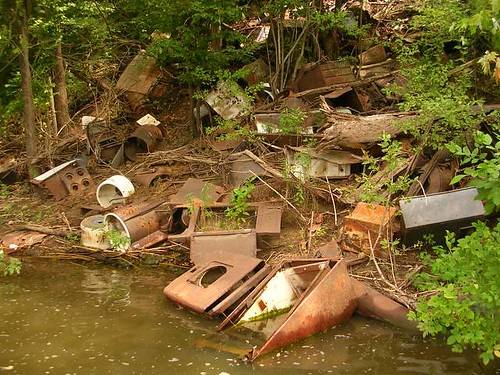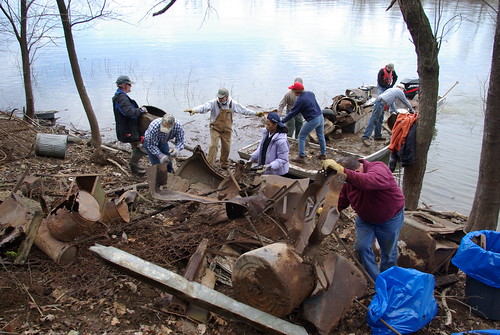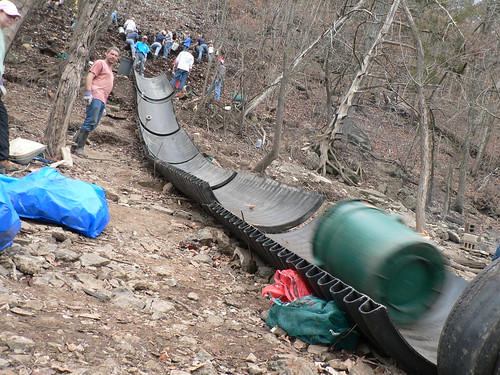Mari-Osa Dump Clean-up
March 7, 2009
Mari-Osa MDC Public Access, Osage River
check out our Mari-Osa results page
March 7, 2009
Mari-Osa MDC Public Access, Osage River
check out our Mari-Osa results page
The Mari-Osa
There is a spot along the Osage River where the Maries River valley enters just below a row of high bluffs, referred to as the Mari-Osa Delta. For years this was the location of the Huber Ferry, shuttling folks coming to and from between the state capitol and places eastward across the wide Osage.
Now a bridge crosses the river there, and a string of campgrounds, cabins and trophy homes lines the river. One of the legacies of being a conduit of human traffic for so many years is the Huber Dump. For decades, everyone in the area used this easy bluff access as the place to dump everything they didn’t want any more. The bluff top, called by some “Contemplation Point” was also a popular hang out.
The Dump
“Saturday, we’d load up a pickup truck with junk and drive up to the bluff and dump it off,” said one long-time local who shall remain unnamed. “That night we’d go back with a case of beer, party and throw the empty cans off the bluff.
The Dept. of Conservation shut the dump down a couple decades ago, stringing a cable across the roadside above, and busting dumpers. Most of the trash we’ve found there seems to be decades old.
Over the years, the dump was a landmark, a curiosity and, to some, an embarrassment. At last year’s Mari-Osa Dump Clean-up, one of the volunteers from one of the nearby towns talked about this. “We have a sister town in Germany and a few years ago a group of people from that town came here to visit,” she said. Some locals took the visitors on a cruise up the Osage. The travelers remarked on the beauty of the river and how it reminded them of Germany. But when they saw the dump they were kind of outraged. “When I heard it was going to get cleaned up, I had to come help.”

The "Before" Shot - this is what it looked like before the clean-up started. photo by Racin' Dave Stevens
Others just viewed it as a reminder of times past, of a time not long ago when there wasn’t trash service, when metal wasn’t easily scrapped or recycled. And from what I’ve seen, most folks are glad to see it go away.
One of those people is Jeff Finley, a biologist for the US Fish and Wildlife Service who has helped at many River Relief clean-ups and learning festivals over the years. A few years back, we were doing a clean-up at the mouth of the Osage, and he mentioned the dump and suggested we check it out. Racin’ Dave and Anthony scouted it out on their way home and the challenge was on.
“For years I’ve been cruising by that dump on my shoal runner,” he said. “I’d always thought somebody outta do something about that mess. Then I realized I knew just the people to do it.”
Over the years, the dump settled into pseudo-geologic layers: big appliances, cars, tires and farm implements moved to the bottom, spilling into the river. Uphill is a plume of steel cans, small toys, random household utensils and bottles. The entire thing is under laid with a layer of broken glass and shards of steel. Not exactly safe and really ugly.
Last year we held a clean-up of the dump, focusing on the big stuff at the base of this pile. Volunteers pulled almost 20 tons of junk out of there, shuttled across the river by boat to the Mari-Osa boat ramp at the base of the 50/63 bridge.

The 2008 Mari-Osa Clean-up - the view from the hill. photo by Lindsay Tempinson
This year we decided to start working uphill, and also put crews out on some of the other old dumps along that stretch. We debated for months on what the best approach was and came to the conclusion that we could really use a chute to quickly and safely slide trash down the steep, dangerous hill. One of our crew volunteers, Liz Doubet was looking around for rental donation of a construction chute when the brainstorm hit John Breyfogle.
The Flume (should be pronounced with a French accent)
John “Capt. Brey” Breyfogle, longtime River Relief crewmember and also member of the Alligator Cove Stream Team #1876, lives along the Missouri River just downstream of the Kansas City metro area. During the 2007 flooding, a new sandy beach began to form in the cove. Also deposited there was a 20 foot long, 4 foot wide plastic culvert, corrugated on the outside and smooth on the inside. He started calling the new beach “Culvert Beach”.
A couple weeks ago he called up with his idea. He’d dig out the culvert and cut it into pieces that could be reassembled into a flume to shoot trash cans down the hill. With a shovel, a saws-all and his neighbor’s backhoe, he went at it. Even after getting 5 inches of snow!
He hauled the pieces on his trailer to the ramp on the Friday before the clean-up. We loaded it in the Saskia and shuttled it over to the dumpsite. After a little head scratching, we decided it should go from the first terrace to the river. Trash would get loaded into trash cans up top, then dropped down the flume and either loaded in boats or bagged up so the cans could go back up again.

Adrian Andrei from Lincoln University oversees the trash flume operation at our 2009 clean-up.
photo by Emily Kunz
The pieces were laid out on the hill, screwed together into a flume, and staked in place with rebar.photo by Emily Kunz
It worked flawlessly. All day long, trash cans full of debris (mostly recyclable steel cans) went flying down the flume, where they were moved into boats and shuttled across to the ramp. Awesome!!


No comments:
Post a Comment